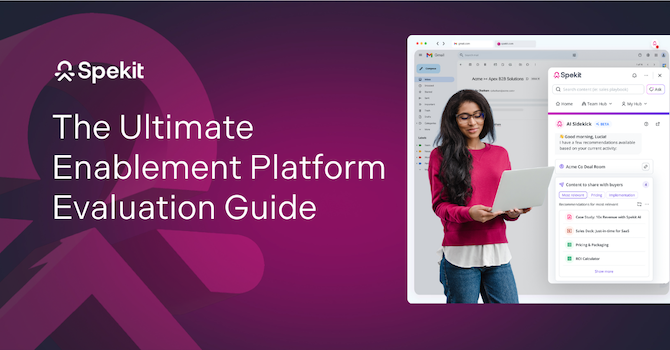It’s not uncommon for companies to be excellent at selling their products or services and not so excellent at collecting the actual revenue. Individual instances of revenue leakage might not seem like a big deal on their own—waived service charges here, ho-hum employee development there. But these instances can add up fast. Roughly 45% of businesses experience revenue leakage, and they lose an average of 9% of their annual revenue because of it.
Revenue leaks spring across the funnel, so they take on many different forms. This makes them tough to spot. Everything from poor data management to inefficient processes and misaligned teams are all revenue leakage red flags. Without systems to detect and fix leaks, small gaps compound. Programs that combine in-workflow guidance with clear reporting make it easier to see which efforts move deals forward and where performance breaks down.
So what should those systems look like? Let’s explore everything you need to know about revenue leakage and exactly how to stop it.
What is Revenue Leakage?
Popularized by revenue platform Clari, revenue leakage is when a business loses expected income. (You might also hear it referred to as profit drain, income erosion, revenue seepage, and revenue loss, among other revenue leakage synonyms.)
Much like water leaking from a pipe, money that should have been earned slips away for reasons that range from bad data and inaccurate billing to weak content governance that lets outdated guidance reach reps and buyers. The longer revenue leaks like these go unnoticed, the more time they have to undermine your company’s bottom line.
Why Do You Need to Measure Revenue Leaks?
The importance of measuring revenue leakage cannot be understated since letting even the tiniest of revenue leaks slide can eventually domino into major financial setbacks for your business.
Just as a plumber repairs leaky pipes to save water, businesses must diagnose and seal off revenue leaks to safeguard the company’s income and ensure financial stability. Revenue leaks can also offer a hint of underlying process inefficiencies at play—seal off your leaks, and adjacent processes and strategies will likely become leaner and more efficient, too.
How to Calculate Revenue Leakage
To calculate how much revenue leakage you’re up against, add how much income your company should be generating and the money you’ve received.
The difference between these two numbers (income generated minus payments received) is your estimated revenue leakage.

Examples of Revenue Leakage
Revenue leakage can manifest in a variety of ways. Some of the more common examples of revenue leakage include:
- Human error. Employees manually enter data or process invoices that contain profit-draining errors.
- Ineffective pricing strategies. Your company fails to adjust prices in response to market changes or customer habits—or has been undercharging from the jump.
- Invoicing errors. An updated price point isn’t recorded in your subscription management system, so customers are charged old rates.
- Involuntary churn. Renewals lapse due to outdated customer data, such as expired credit cards or MIA backup payment options.
- Slipped deals. A discount approval request takes too long for finance to sign off on, so the customer abandons the deal and goes elsewhere.
- Misapplied discounts. Customers scale back their operations but still receive the initial discount they received before scaling back.
- Missed opportunities for upselling or cross-selling. Your company relies on general-purpose AI instead of purpose-built enablement, so guidance is not governed, tracked, or delivered in the flow of work when reps need it.
Common Causes of Revenue Leakage
A range of issues can cause businesses to lose the income they were supposed to earn. While every business is distinct, there are common causes of revenue leakage that all businesses should keep tabs on.
Billing Errors and Inefficiencies
One of the primary culprits of revenue leakage is billing errors and inefficiencies, especially with recurring payments. Many of today’s businesses offer multiple tiers, pricing packages, and billing cycle options, the intricacies of which open the door to errors that can contribute to revenue loss. Common income-draining errors include manual invoicing and lenient discounting policies.
Revenue enablement faux pas, like sales teams not getting a heads up about pricing updates, billing systems sourcing the wrong payment data, and businesses not putting a dunning process in place, can all contribute to lower-than-expected earnings.
Inaccurate Forecasting
Building an accurate sales forecast helps businesses set realistic goals and make the necessary operational decisions (think: hiring, budgets, and investments) to achieve them. When forecasts are built on imperfect data and fractured systems without observability into what content and guidance actually moved deals, revenue leakage shifts from a possibility to a pattern.
Voluntary Churn
When a customer ends their subscription or downgrades their plan to a lower-tier option, this is voluntary churn. The more unresolved problems within the customer’s journey, the more a customer’s dissatisfaction will motivate them to either leave or downgrade. Cue revenue leakage.
Issues with Internal Communication
Many costly mistakes can happen when your sales and customer success teams are misaligned. If your sales team hasn’t been kept in the loop on pricing structure or policy updates, for instance, they might undercharge for specific packages or not charge an additional fee for a certain service that should be sold as an add-on. Implementing a revenue operations software can help streamline communication, ensuring all revenue-generating teams have access to the most up-to-date information.
Internal communication issues like poor training and knowledge sharing can also strike within your sales team. Without personalized sales enablement training and top-notch sales collateral management, you risk income-draining issues like slow ramp times, long sales cycles, and outdated playbooks.
High Cost of Customer Acquisition
It’s not uncommon for businesses to spend time and resources on customer acquisitions. But without concrete benchmarks to keep these investments in check, even just a handful of customer acquisitions can drain a significant portion of your revenue and, if you’re not careful, cost you more than the results you’re getting.
How to Find Revenue Leaks

Finding revenue leaks involves going into detective mode and combing your operations to see where the numbers don’t add up. These are the best ways to locate the causes of revenue leakage across your pipeline:
Conduct Regular Audits
Regular audits of your sales pipeline and revenue processes can help you spot revenue leaks before they do too much damage and, eventually, stop potential leaks before they start.
You might start by looking at:
- Sales and operations processes. Walk through every step, from prospecting to onboarding. How do handoffs work? Are there any bottlenecks or inefficiencies? Anomalies that might indicate revenue leakage?
- Data capturing processes. Explore where and how data is collected and maintained and whether it’s accurate and up-to-date.
- Your tech stack. Check for software glitches, unused features, or poor integrations that might be causing billing errors or lost data.
- Team feedback. Find out if your customer-facing teams have noticed any workflow inefficiencies that could be causing losses.
- Customer feedback. Have past customers mentioned billing confusion or other discrepancies that might still be in play?
Once you’ve looked into the above, you should have a solid grasp of whether you have revenue leaks and where they originate.
Assess Pricing Model
Pricing strategies are pivotal in hitting the brakes on—or exacerbating—revenue leakage. Common ways pricing can go wrong include undercharging, setting prices that don’t align with market benchmarks, and missing out on upselling opportunities.
Analyze Failure Rates
If your reps aren’t hitting their quotas, finding out why is another way to pinpoint revenue leaks and lower the cost per acquisition. Are they chasing low-quality leads? Does your user adoption strategy need work? What are they doing—or not doing—compared to reps who consistently hit their quotas?
Tips for Preventing Revenue Leakage
Once you’ve nailed down your company’s specific causes of revenue leakage, it’s time to seal off the leaks and prevent new ones from springing. Here are the best ways to get the job done.
1. Create a Single Source of Truth
A single source of truth is a knowledge management principle that involves collecting data across all customer-facing teams and aggregating it into a central repository. This breaks down data silos between departments and ensures that your entire revenue team—sales, marketing, customer success, and RevOps—is using the most accurate and up-to-date information to move prospects through the pipeline. Tight governance and observability prevent outdated or risky files from circulating and let leaders measure which guidance actually advances deals.
Spekit is the modern AI-powered enablement platform that unifies content management, enablement, and personalized guidance so teams can access accurate, governed knowledge in their flow of work.
2. Automate Manual Processes and Fix Payment Workflows
Manual processes, especially repetitive tasks like invoicing and payment processing, are a breeding ground for revenue leakage caused by human error. Automating repetitive tasks reduces manual errors and saves time your team can use to generate more revenue.
Comb through your sales processes and payment workflows and decide which tasks should be automated. These might include:
- Creating and managing contacts
- Identifying, tracking, and scoring leads
- Generating baseline content for playbooks, sales scripts, and more with Spekit AI
- Personalizing sales email outreach
- Notifying reps when it’s time to follow up with buyers after sending content in a Spekit Deal Room
- Accelerating deals and improving decision-making with analytics and insights
- Streamlining payment workflows, such as upcoming payment reminders, late payment notifications, recurring payments and subscriptions, and payment confirmation emails
- Resolving routine requests from customers
3. Prioritize Revenue Enablement Strategy
Revenue enablement optimizes every customer touchpoint to create a seamless and successful experience. Creating the right cocktail of sales and revenue enablement planning with a top-notch enablement platform maximizes revenue in several ways.
Formalizing and prioritizing a revenue enablement strategy:
- Unifies customer-facing teams under one digital roof
- Creates alignment in resources, training, and technology
- Streamlines cross-functional collaboration
- Defines clear targets
- Repairs a fragmented customer experience
- Eliminates ineffective touchpoints
With a clear strategy, every team knows the revenue enablement goals and specific KPIs they should keep tabs on to find potential areas of loss, including revenue growth, customer churn, average revenue per user, renewal rates, and customer lifetime value. It’s also much easier to catch process errors and glitches before they become revenue leaks.
With Spekit as your go-to enablement platform, customer-facing teams will have instant access to playbooks and other vital sales collateral in any tool or workflow. Notify teams of new content and process changes with in-app alerts, provide them with bite-sized training directly in their workflow, and enable automatic access to the exact content they need to close when needed.
In addition to being one of the best Salesforce integrations, Spekit is available in Chorus, Gong, Gmail, Salesloft, Outlook Web App, and more.
4. Improve Sales Processes

Between ever-changing customer needs and clunky, bloated tech stacks, most reps spend a whopping 3 to 11 hours per week searching for answers to questions about tools, processes, or information. No wonder less than 30% of their time is spent actually selling.
By optimizing your sales processes with Spekit, training and guidance, processes, and sales plays are accessible in the flow of work. The result? Revenue enablement that allows your reps to achieve 69% more time selling, 70% deal save rate increase, and 20% higher quota attainment.
Supporting your sales team and giving them the necessary tools helps limit revenue leakage by improving data quality, reducing content gaps, and enhancing buyer interactions. Teams frequently cite content decay and low adoption as drivers for switching platforms, and 24.2% report that over 80% of their content is not used. Addressing decay and trust is critical to stop leaks.
Spekit combines intelligent content management with an AI-powered enablement layer that delivers just-in-time guidance across your stack. Centralize and govern content once, then make it instantly available in the tools reps already use with AI Sidekick. Sidekick interprets signals from systems like CRM and call intelligence to surface the right content, coaching, and next best actions, reducing context switching and driving consistent execution.
Spekit offers additional enablement features that can halt revenue leakage within your sales processes, including:
- Onboarding and training: Ongoing learning that evolves as your sales processes do
- Knowledge checks: Knowledge retention assessment with fun, in-app quizzes
- Buyer engagement: Alerts when a customer interacts with shared sales content so reps can follow up with the right message at the right time
- Built-in analytics: Tools to connect your enablement efforts with business outcomes so you can take action with confidence and precision

5. Optimize Your Customer Relationship Management
Companies lose as much as 10% of their annual revenue to lower-quality CRM data, which can cause reps to miss out on high-potential opportunities. If your company doesn’t have a clear set of protocols for CRM data entry, odds are it’s causing a hefty amount of revenue leakage.
Insufficient data also means you’re missing out on valuable insights into your audience, which can lead to other forms of revenue leakage, such as missed upsell opportunities and inaccurate forecasts.
It’s not enough to consolidate your data onto a single CRM platform. You need to ensure customer-facing teams synchronize all customer interactions consistently and correctly. Integrating Spekit with your CRM software drives adoption and process retention by providing step-by-step tutorials in the programs where teams complete their tasks.
If your team can access the knowledge and tools they need when they need it, you’ll see improved data management, streamlined sales activities, enhanced customer interactions, and optimized customer-facing team operations.
Stop Revenue Leaks with the Right Enablement Platform
Tackling revenue leakage is crucial to maintaining your company’s financial stability and growth. Having the right enablement platform in your corner can help you stay on top of your entire pipeline, from prospecting to final sale, and stop revenue leaks before they start.
So, what’s the best way to seal off revenue leaks and prevent new ones from springing? Add Spekit, the modern AI-powered enablement platform that unifies content management, enablement, and personalized guidance to help teams automate workflows and close deals quicker to your tech stack. Designed to meet the agile nature of today’s sales landscape, Spekit helps you identify revenue-draining inefficiencies, automate critical workflows, and make every rep your best rep.

.png)





